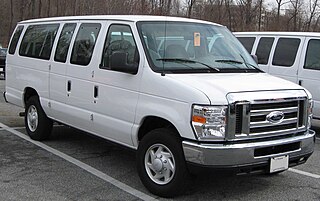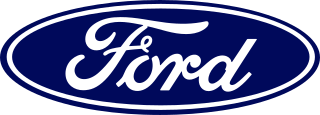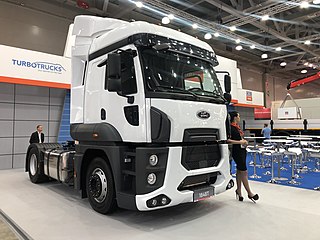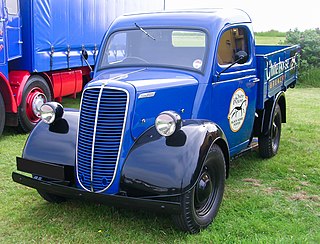Iveco S.p.A., an acronym for Industrial Vehicles Corporation, is an Italian multinational transport vehicle manufacturing company with headquarters in Turin, Italy. It designs and builds light, medium, and heavy commercial vehicles. The name IVECO first appeared in 1975 after a merger of Italian, French, and German brands. Its production plants are in Europe, China, Russia, Australia and Latin America and it has about 5,000 sales and service outlets in over 160 countries. The worldwide output of the company amounts to around 150,000 commercial vehicles with a turnover of about €10 billion.

Unic was a French manufacturer founded in 1905, and active as an automobile producer until July 1938. After this the company continued to produce commercial vehicles, retaining its independence for a further fourteen years before being purchased in 1952 by Henri Pigozzi, who was keen to develop Unic as a commercial vehicle arm of the then flourishing Simca business.

The Ford E-Series is a range of full-size vans manufactured and marketed by the Ford Motor Company. Introduced for 1961 as the replacement of the Ford F-Series panel van, four generations of the model line have been produced. Marketed for both cargo and passenger transport configurations, the E-Series has been designed with multiple design variations for both retail and commercial sale, including vans, and commercial-grade cutaway van chassis and stripped chassis.

The Ford F-Series is a series of light-duty trucks marketed and manufactured by Ford Motor Company since the 1948 model year. The F-Series is marketed as a range of full-sized pickup trucks positioned above the midsize Ranger but below the larger Super Duty in the Ford truck lineup. Alongside the F-150, the F-Series also includes the Super Duty series, which includes the heavier-duty F-250 through F-450 pickups, F-450/F-550 chassis cabs, and F-600/F-650/F-750 Class 6–8 commercial trucks.

The International Harvester Company was an American manufacturer of agricultural and construction equipment, automobiles, commercial trucks, lawn and garden products, household equipment, and more. It was formed from the 1902 merger of McCormick Harvesting Machine Company and Deering Harvester Company and three smaller manufacturers: Milwaukee; Plano; and Warder, Bushnell, and Glessner. Its brands included McCormick, Deering, and later McCormick-Deering, as well as International. Along with the Farmall and Cub Cadet tractors, International was also known for the Scout and Travelall vehicle nameplates. In the 1980s all divisions were sold off except for International Trucks, which changed its parent company name to Navistar International.

Seddon Atkinson Vehicles Limited, was a manufacturer of large goods vehicles based in Oldham, Greater Manchester, England, was formed after the acquisition in 1970 of Atkinson Vehicles Limited of Preston by Seddon Diesel Vehicles Limited of Oldham. In 1974, the firm was acquired by International Harvester, which sold it in March 1984 to the Spanish group Enasa which made it a subsidiary of Pegaso. In 1990, it became part of Iveco which used the brand for various types of specialised vehicles in the United Kingdom. The range of models produced included EuroMover, Pacer and Strato, which are aimed at refuse collection, recycling and construction operators.

The Loyd Carrier was one of a number of small tracked vehicles used by the British and Commonwealth forces in the Second World War to transport equipment and men about the battlefield. Alongside the Bren, Scout and Machine Gun Carriers, they also moved infantry support weapons.

The Thames Trader was a range of trucks manufactured by Ford UK built between 1957 and 1965.
Bedford Vehicles, usually shortened to just Bedford, was a brand of vehicle manufactured by Vauxhall Motors, then a subsidiary of multinational corporation General Motors. Established in April 1931, Bedford Vehicles was set up to build commercial vehicles. The company was a leading international lorry brand, with substantial export sales of light, medium, and heavy lorries throughout the world.

Ford Motor Company Limited, trading as Ford of Britain, is a British wholly owned subsidiary of Ford Technologies Limited, itself a subsidiary of Ford International Capital LLC, which is a subsidiary of Ford Motor Company. Its business started in 1909 and has its registered office in Laindon, Essex. It adopted the name of Ford of Britain in 1960.

The medium-duty version of the Ford F-Series is a range of commercial trucks manufactured by Ford Motor Company since 1948. Derived from the smaller F-Series pickup trucks, the medium-duty range is currently in its eighth generation. Initially slotted between the F-Series pickup trucks and the "Big Job" conventionals, later generations were slotted below the L-Series "Louisville" trucks; the last two generations are the largest vehicles produced by Ford since its exit from the heavy-truck segment.

The Ford Cargo is a forward-control (cab-over-engine) truck model manufactured by Ford since 1981. Designed by Ford of Britain as the successor of the Ford Transcontinental heavy commercial tractor, Ford introduced the Cargo to North America for 1986 as a medium-duty truck, intended to replace the long-running Ford C-Series.

The Ford Thames 400E is a commercial vehicle that was made by Ford UK and introduced in 1957. Production of the range continued until September 1965, by which time a total of 187,000 had been built. Publicity for the model included hiring the Cy Laurie band to make the promotional film short 'Band Wagon', in 1958, preserved in the 'Ford Film and Video Collection' at the National Motor Museum, Beaulieu

The Iveco Daily is a large light commercial van produced by the Italian automaker Iveco since 1978; it was also sold as the Fiat Daily by Fiat until 1983. Unlike the more car-like unibody Fiat Ducato, the Daily uses a separate ladder frame typical of heavier commercial vehicles. The Iveco Daily is produced at the Iveco Suzzara plant, near Mantova in Italy, where Iveco has recently made substantial investments to renew the production lines.

The Urals Automotive Plant, an Open Stock Company, is a major Russian manufacturer of off-road trucks under the Ural brand. Located in the city of Miass, Chelyabinsk Oblast in the Ural Mountains. The plant was established in 1941; when the ZiS truck plant was evacuated from Moscow during World War II.

The Ford Thames 300E is a car derived van that was produced by Ford UK from 1954 to 1961. The Thames name was given to all available sizes of commercial vehicle produced by Ford in Britain from the 1950s through to 1965. In that year the Thames and Trader names were discontinued.

The Fordson E83W is a 10 cwt light commercial vehicle that was built by Ford of Britain at the Ford Dagenham assembly plant between 1938 and 1957. The van was sold in Australia as the Ford Ten-Ten, and the E83W was available in various forms around much of the world as Britain strove to export after World War II. In some countries, the 'cowl and chassis' only was imported and local bodies built.

Canadian Military Pattern (CMP) trucks were mutually coherent ranges of military trucks, made in large numbers, in several classes and numerous versions, by Canada's branches of the U.S. 'Big Three' auto-makers during World War II, compliant to British Army specifications, primarily intended for use in the armies of the British Commonwealth allies, but also serving in other units of the British Empire.

The Iveco Zeta is a light to medium-duty truck model produced by the Italian manufacturer Iveco. Appearing in 1976 and entering production in 1977, its cab was developed with the aid of Fiat's wind tunnel in Orbassano. The Zeta series continued the lineage begun with the 1959 introduction of the OM Lupetto. The Lupetto, as well as the Leoncino, the Daino, and the Tigrotto, were all replaced by the OM X-series in 1972, which then formed the basis for the Zeta range. The Zeta itself was replaced by the all-new Iveco Eurocargo in 1991.

The Fordson WOT was a military truck produced by Ford of Britain in the Second World War. From 1939 to 1945, around 130,000 units were produced at the Ford Dagenham plant with almost half being the WOT2.


























